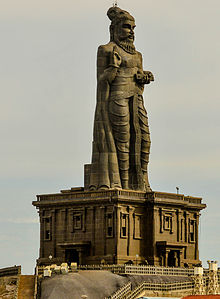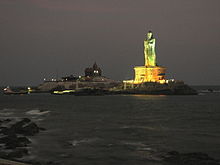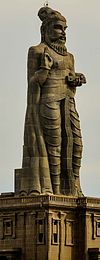
Kanyakumari, officially Kanniyakumari, also known as Cape Comorin, is a city in Kanyakumari district in the state of Tamil Nadu, India. It is the southernmost tip of the Indian subcontinent and the southernmost city in mainland India, and thus referred to as "The Land's End". The city is situated 90 kilometres (56 mi) south of Thiruvananthapuram city, and about 20 kilometres (12 mi) south of Nagercoil, the headquarters of Kanyakumari district.

Thiruvalluvar, commonly known as Valluvar, was an Indian poet and philosopher. He is best known as the author of the Tirukkuṟaḷ, a collection of couplets on ethics, political and economic matters, and love. The text is considered an exceptional and widely cherished work of Tamil literature.

Valluvar Kottam is a monument in Chennai, dedicated to the classical Tamil poet philosopher Valluvar. It is the city's biggest Tamil cultural centre.

Vivekananda Rock Memorial is a monument and popular tourist attraction in Kanyakumari, India's southernmost tip. The memorial stands on one of the two rocks located about 500 meters off mainland of Vavathurai. It was built in 1970 in honour of Swami Vivekananda, who is said to have attained enlightenment on the rock. According to legends, it was on this rock that Goddess Kanyakumari (Parvathi) performed tapas in devotion of lord Shiva. A meditation hall known as Dhyana Mandapam is also attached to the memorial for visitors to meditate. The design of the mandapa incorporates different styles of temple architecture from all over India. The rocks are surrounded by the Laccadive Sea where the three oceans Bay of Bengal, the Indian Ocean and the Arabian Sea meets. The memorial consists of two main structures, the Vivekananda Mandapam and the Shripada Mandapam.

Kanyakumari district is one of the 38 districts of Tamil Nadu state and the southernmost district in mainland India. It stands second in terms of population density among the districts of Tamil Nadu. It is also the richest district in Tamil Nadu in terms of per capita income, and also tops the state in Human Development Index (HDI), literacy, and education. The district's headquarters is Nagercoil.
Parimelalhagar, sometimes spelled Parimelazhagar, born Vanduvarai Perumal, was a Tamil poet and scholar known for his commentary on the Thirukkural. He was the last among the canon of ten medieval commentators of the Kural text most highly esteemed by scholars. He was also among the five oldest commentators whose commentaries had been preserved and made available to the Modern era, the others being Manakkudavar, Pari Perumal, Kaalingar, and Paridhi. Of all the ancient commentaries available of the Kural literature, Parimelalhagar's commentary is considered by scholars as the best both in textual and literary aspects. The codification of the writings of Valluvar is attributed to Parimelalhagar. Parimelalhagar also remains the most reviewed, in terms of both praise and criticism, of all the medieval Kural commentators. Praised for its literary richness and clarity, Parimelalhagar's commentary is considered highly complex and exquisite in its own right that it has several scholarly commentaries appearing over the centuries to elucidate it. Along with the Kural text, Parimelalhagar's commentary has been widely published that it is in itself regarded a Tamil classic.
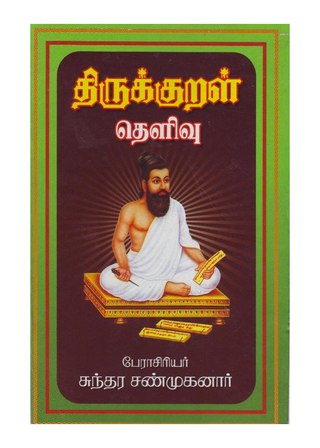
The Tirukkuṟaḷ, or shortly theKural, is a classic Tamil language text consisting of 1,330 short couplets, or kurals, of seven words each. The text is divided into three books with aphoristic teachings on virtue (aram), wealth (porul) and love (inbam), respectively. It is widely acknowledged for its universality and secular nature. Its authorship is traditionally attributed to Valluvar, also known in full as Thiruvalluvar. The text has been dated variously from 300 BCE to 5th century CE. The traditional accounts describe it as the last work of the third Sangam, but linguistic analysis suggests a later date of 450 to 500 CE and that it was composed after the Sangam period.

Sarvajna and Tiruvalluvar are popular Kannada and Tamil poets, respectively. Statues of Sarvajna in Tamil Nadu and Tiruvalluvar in Karnataka has been unveiled in August 2009 as a symbolic effort to bolster ties between the two Indian states, whose relationship has been strained by issues related to sharing of Kaveri water and Hogenakkal water supply power project.
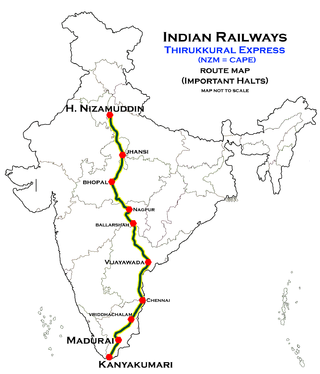
Thirukural Express is a superfast express train in India, running between Kanniyakumari in Tamil Nadu which is the southernmost tip of the Indian Subcontinent, and Hazrat Nizamuddin in New Delhi. From December 2020, it runs with newly manufactured LHB rakes.
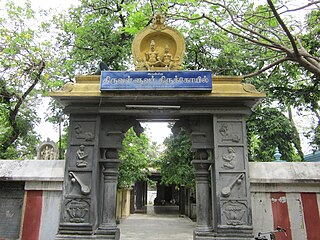
The Ekambareswarar–Kamakshi Temple, commonly known as the Thiruvalluvar Temple, is a Hindu temple dedicated to the poet-saint Valluvar in the neighborhood of Mylapore in Chennai, India. The shrine is located within the Ekambareswarar temple complex. Believed to have been constructed in the early 16th century, the temple was extensively renovated in the 1970s. Traditionally believed to be the birthplace of Saint Valluvar, the temple is the oldest ever built to Valluvar. The temple also serves as the venue for meetings of Tamil language enthusiasts. While many consider the temple as the birthplace of Valluvar, some consider it as his samadhi.
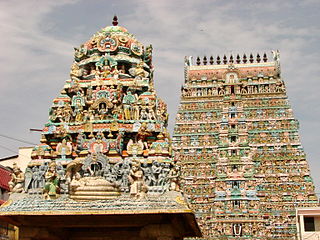
Tamil Nadu is known for its ancient temple architecture. Nearly 33,000 ancient temples, many at least 800 to 2000 years old, are found scattered all over Tamil Nadu. As per Tamil Nadu Hindu Endowments Board, there are 38,615 temples. Most of the largest Hindu Temples reside here. Studded with complex architecture, a variety of sculptures, and rich inscriptions, the temples remain the very essence of the culture and heritage of Tamil land, with historical records dating back to at least 3,000 years.
The Tirukkural, shortly known as the Kural, is a classic Tamil sangam treatise on the art of living. Consisting of 133 chapters with 1330 couplets or kurals, it deals with the everyday virtues of an individual. Authored by Valluvar between the first century BCE and 5th century CE, it is considered one of the greatest works ever written on ethics and morality and is praised for its universality and non-denominational nature.
Yu Hsi is a Taiwanese Tamil poet and scholar who has translated the Tirukkural and the poems of Subramaniya Bharathi and poet Bharathidasan in Mandarin. He is the founder and president of the Tamil Sangam in Taiwan. He has received various awards, including awards from Seoul World Academy of Arts and Culture (2004), Thiruvalluvar Award (2014), and a felicitation from former President of India A. P. J. Abdul Kalam.
Tirukkural, also known as the Kural, an ancient Indian treatise on the ethics and morality of the commoner, is one of the most widely translated non-religious works in the world. Authored by the ancient Tamil poet-philosopher Thiruvalluvar, it has been translated into at least 42 world languages, with about 57 different renderings in the English language alone.

Tirukkural remains one of the most widely translated non-religious works in the world. As of 2014, there were at least 57 versions available in the English language alone. English, thus, continues to remain the language with most number of translations available of the Kural text.
As of 2015, the Japanese language has two translations available of the Tirukkural.
Korean has at least two translations of the Tirukkural available as of 2017.
The Book ofAṟam, in full Aṟattuppāl, also known as the Book of Virtue, the First Book or Book One in translated versions, is the first of the three books or parts of the Kural literature, a didactic work authored by the ancient Indian philosopher Valluvar. Written in High Tamil distich form, it has 38 chapters each containing 10 kurals or couplets, making a total of 380 couplets, all dealing with the fundamental virtues of an individual. Aṟam, the Tamil term that loosely corresponds to the English term 'virtue', correlates with the first of the four ancient Indian values of dharma, artha, kama and moksha. The Book of Aṟam exclusively deals with virtues independent of the surroundings, including the vital principles of non-violence, moral vegetarianism, veracity, and righteousness.
The dating of the Tirukkural, and by extension the period of its author Valluvar, has been a subject of intense debate among scholars for centuries, and it continues to remain so. The Kural is variously dated between 300 BCE and 5th century CE. According to Blackburn, the "current scholarly consensus" dates the text and the author to approximately 500 CE. The Tamil Nadu government has ratified 31 BCE as the year of birth of Valluvar. Still the precise date as to when Valluvar completed writing the Kural text remains murky. This article speaks about various dates arrived at by various scholars over time.
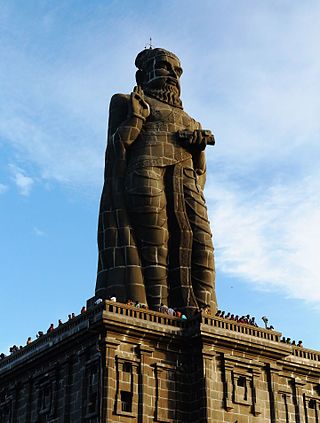
Valluvar year, also known as the Thiruvalluvar year, is an officially recognized Tamil calendar system for use in Tamil Nadu. It is calculated on the basis of the supposed year of birth of the Tamil poet-philosopher Valluvar. When comparing it with the widely used Gregorian calendar, Thiruvalluvar year will have an additional 31 years. For instance, the year 2024 in Gregorian calendar way is 2055 in the Thiruvalluvar year.
